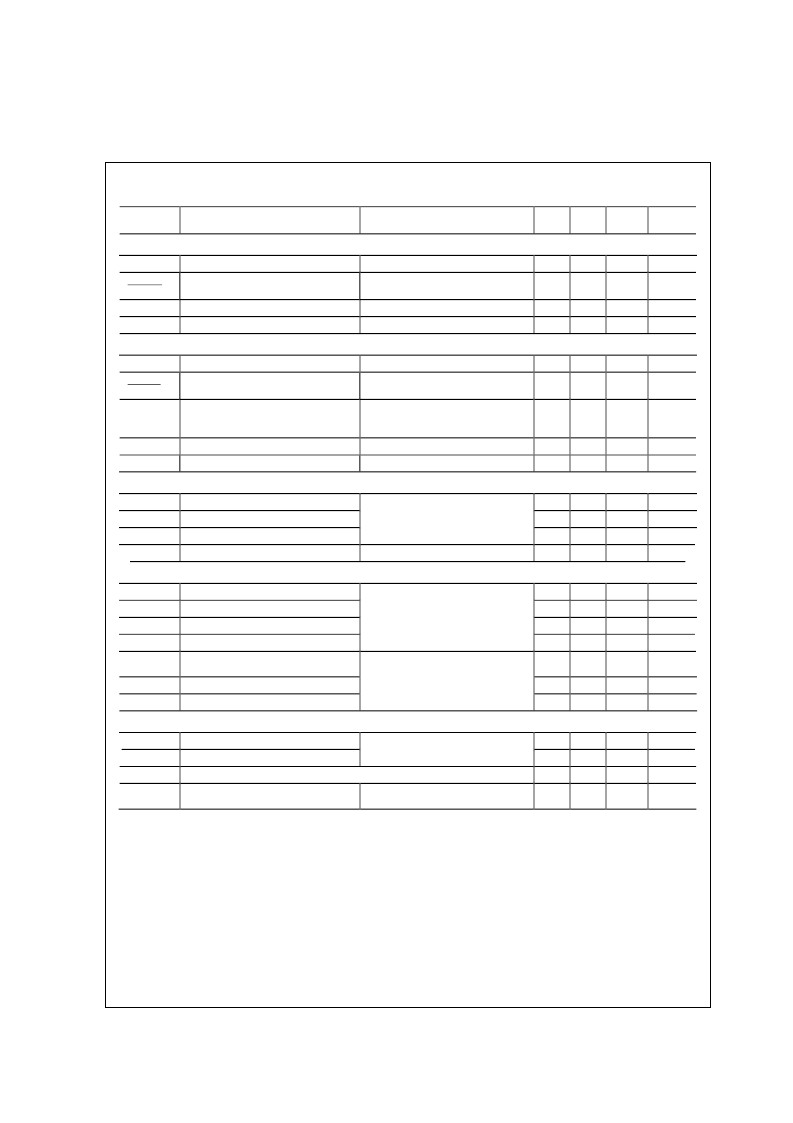- 您現(xiàn)在的位置:買賣IC網(wǎng) > PDF目錄371401 > 2502P (Fairchild Semiconductor Corporation) Dual P-Channel 2.5V Specified PowerTrench MOSFET PDF資料下載
參數(shù)資料
| 型號: | 2502P |
| 廠商: | Fairchild Semiconductor Corporation |
| 英文描述: | Dual P-Channel 2.5V Specified PowerTrench MOSFET |
| 中文描述: | 雙P溝道MOSFET的為2.5V指定的PowerTrench |
| 文件頁數(shù): | 2/5頁 |
| 文件大小: | 150K |
| 代理商: | 2502P |

FDW2502P Rev. F (W)
Electrical Characteristics
T
A
= 25°C unless otherwise noted
Test Conditions
Symbol
Parameter
Min
Typ Max Units
Off Characteristics
BV
DSS
Drain–Source Breakdown Voltage
BV
DSS
T
J
Coefficient
I
DSS
Zero Gate Voltage Drain Current
I
GSS
Gate–Body Leakage
V
GS
= 0 V, I
D
= –250
μ
A
–20
V
Breakdown Voltage Temperature
I
D
= –250
μ
A, Referenced to 25
°
C
–14
mV/
°
C
V
DS
= –16 V,
V
GS
=
±
12 V,
V
GS
= 0 V
V
DS
= 0 V
–1
±
100
μ
A
nA
On Characteristics
V
GS(th)
Gate Threshold Voltage
V
GS(th)
T
J
Temperature Coefficient
R
DS(on)
Static Drain–Source
On–Resistance
(Note 2)
V
DS
= V
GS
, I
D
= –250
μ
A
–0.4
–0.9
–1.5
V
Gate Threshold Voltage
I
D
= –250
μ
A, Referenced to 25
°
C
3.2
mV/
°
C
V
GS
= –4.5 V,
V
GS
= –4.5 V, I
D
= –4.4 ,T
J
=125
°
C
V
GS
= –2.5 V,
I
D
= –3.3 A
V
GS
= –4.5 V,
V
DS
= –5 V
V
DS
= –5 V,
I
D
= –4.4 A
I
D
= –4.4 A
27
35
38
18
35
56
57
m
I
D(on)
g
FS
On–State Drain Current
Forward Transconductance
–30
A
S
Dynamic Characteristics
C
iss
Input Capacitance
C
oss
Output Capacitance
C
rss
Reverse Transfer Capacitance
R
G
Gate Resistance
1465
310
155
7.7
pF
pF
pF
V
DS
= –10 V,
f = 1.0 MHz
V
GS
= 0 V,
V
GS
= 15 mV, f = 1.0 MHz
Switching Characteristics
(Note 2)
t
d(on)
Turn–On Delay Time
t
r
Turn–On Rise Time
t
d(off)
Turn–Off Delay Time
t
f
Turn–Off Fall Time
14
8
51
29
25
16
82
47
ns
ns
ns
ns
V
DD
= –10 V,
V
GS
= –4.5 V,
I
D
= –1 A,
R
GEN
= 6
Q
g
Total Gate Charge
V
DS
= –5 V,
V
GS
= –5 V
I
D
= –4.4 A,
15
21
nC
Q
gs
Q
gd
Gate–Source Charge
Gate–Drain Charge
2.9
3.5
nC
nC
Drain–Source Diode Characteristics and Maximum Ratings
t
rr
Q
rr
Diode Reverse Recovery Charge
I
S
Maximum Continuous Drain–Source Diode Forward Current
Drain–Source Diode Forward
Voltage
21
8.1
ns
nC
I
F
= –4.4 A,
d
iF
/d
t
= 100 A/μs
–0.83
A
V
SD
V
GS
= 0 V,
I
S
= –0.83 A
(Note 2)
–0.7
–1.2
V
Notes:
1.
R
θ
JA
is the sum of the junction-to-case and case-to-ambient thermal resistance where the case thermal reference is defined as the solder mounting surface of
the drain pins. R
θ
JC
is guaranteed by design while R
θ
CA
is determined by the user's board design.
a) R
θ
JA
is 125
°
C/W (steady state) when mounted on a 1 inch2 copper pad on FR-4.
b) R
θ
JA
is 208
°
C/W (steady state) when mounted on a minimum copper pad on FR-4.
2.
Pulse Test: Pulse Width < 300
μ
s, Duty Cycle < 2.0%
F
相關(guān)PDF資料 |
PDF描述 |
|---|---|
| 2507 | BUCHSE EINBAU DIN STANDARD 7POL |
| 25085 | KORROSIONSSPERRE 5L |
| 25093 | Low-Power, SPST, Fast, CMOS Analog Switch |
| 25098 | SCHNEIDEMITTEL 5L |
| 25103 | SCHNEIDEMITTEL 500ML |
相關(guān)代理商/技術(shù)參數(shù) |
參數(shù)描述 |
|---|---|
| 2502-SCREW | 制造商:Marathon Special Products 功能描述: |
| 2502SFTW | 制造商:Panasonic Industrial Company 功能描述:IC |
| 2502-US | 制造商:KEITHLEY 功能描述:PICOAMMETER; DMM Type:Bench; Current Measuring Range DC:2nA to 20mA; Current Measuring Range AC:2nA to 20mA; No. of Digits / Alpha:6-1/2; DMM Functions:AC/DC Current; Ranging:Auto, Manual |
| 2503 | 功能描述:安裝硬件 NYLON KNURL HEAD THUMB SCREW RoHS:否 制造商:Harwin 類型:SMT Cable Clip 材料:Phosphor Bronze 安裝孔大小: 長度:5 mm 外徑: 內(nèi)徑: 厚度: 電鍍:Tin 螺紋大小: |
| 250-3 | 制造商:Raaco 功能描述:Bulk |
發(fā)布緊急采購,3分鐘左右您將得到回復。